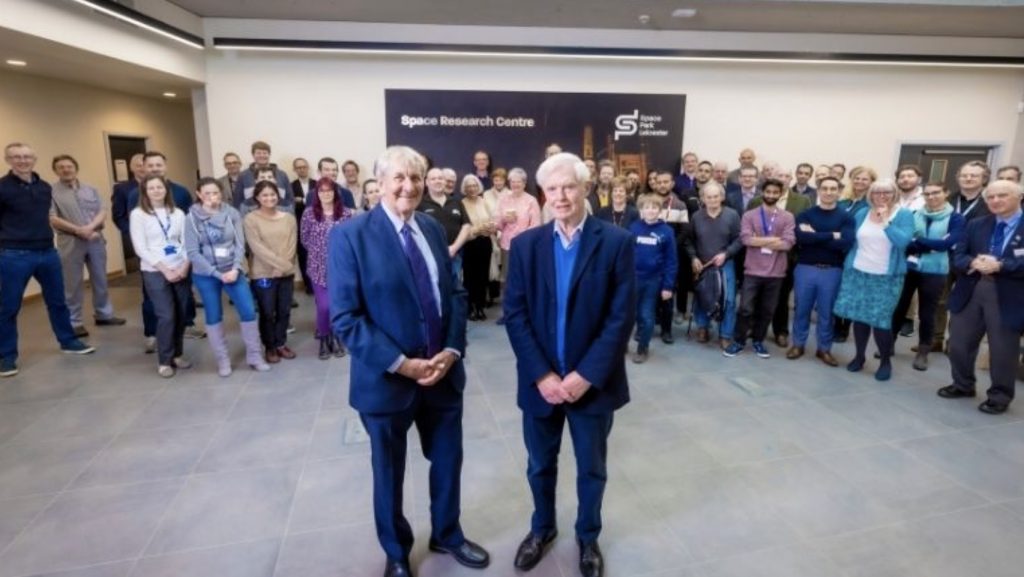Two of Leicester’s first space scientists have returned to open the region’s state-of-the-art Space Research Centre, more than 60 years on.
Professor Ken Pounds CBE, founder of the University of Leicester’s Space Research Group in 1960, and Professor Alan Wells, founding director of the Space Research Centre, cut the ribbon on the new facility at Space Park Leicester on Tuesday.

The pair were joined by researchers and engineers who conduct the Centre’s cutting-edge work in 2022, under the leadership of Director, Professor Mark Sims.
Facilities include a 300sq m clean room for the manufacture and testing of satellites and space instrumentation, plus specialised workshops and laboratories incorporating Artificial Intelligence (AI), digital and advanced manufacturing technologies.
Professor Pounds, Emeritus Professor of Space Physics and the founder of space research in Leicester, gave a brief account of how space research came to Leicester 62 years ago, and how that evolved into the broad, international programme now based in the city. His talk formed part of the University’s Centenary celebrations. He said: “The Space Age essentially began with the launch of Sputnik in 1957. At that time I was studying for a PhD in the Rocket Group at UCL, with the task of developing experiments to measure solar radiation – and it turned out Leicester had just the vacuum x-ray facilities I needed for essential pre-flight checks.
“As the UK space research programme rapidly expanded, Leicester was then the obvious location for a new research group with a remit to study ‘X-radiation from the Sun and other stellar sources’, set up in January 1960.
“With our international reputation established through Skylark rocket flights from Woomera, Australia, and the use of X-ray satellites to provide even deeper observations, Leicester was a partner of choice throughout the 1980s and 90s for international collaborations with the USA, Japan and Germany.
“This was a happy situation but one that demanded expanded facilities. Eventually that need was met by the sale of University land to fund the on-campus Michael Atiyah Space Research Centre. Today, that crucial resource moves to Space Park, where I trust it will long reside as the beating heart of Space Park Leicester.”
As well as serving as the first director of Leicester’s ground-breaking Space Research Centre, Professor Wells was, alongside Professor Pounds, also a key driver of the project which would become the National Space Centre which neighbours Space Park Leicester. He added: “From its very beginning, the Space Research Centre has sought to create opportunities for advancing space science and applications by adapting the results from innovative laboratory research, incorporating advanced technologies, often in partnership with industry, to provide reliable, highly durable, equipment for some of the world’s most productive space science and space application programmes.
“The scientific returns from missions such as XMM-Newton and SWIFT, whose instruments were built and launched around two decades ago, continue to support prolific scientific research in Leicester and many other research institutes internationally. Instruments recently launched on BepiColombo and the James Webb Space Telescope have their origins in preparatory work carried out in the Space Research Centre over the past decade or more.
“The University’s investment in its first Space Research Centre in 1994 has paid enormous dividends. The investments in the new facilities that are now provided in this magnificent new version of the Space Research Centre will surely create many new and exciting opportunities, and not only in Leicester’s traditional scientific centres of excellence in astrophysics and Earth Observation science.
“The new Space Research Centre also positions Leicester to be able to respond to new challenges in climate change mitigation, planetary exploration and the commercial applications of space technology, data and services that are coming over the horizon. It certainly has an exciting future ahead. I congratulate Mark and his team on what they have built here. I am in awe.”
The Space Research Centre’s work builds on Leicester’s long-standing heritage of space instrumentation and manufacturing.
There are currently nine Leicester-built instruments in space, the most recent of which are the Mercury Imaging X-ray Spectrometer (MIXS) currently onboard ESA’s BepiColombo mission to Mercury, and the UK-led Mid-Infrared Instrument (MIRI) for the James Webb Space Telescope.
Current priorities include the development of new technologies and instruments for the support of sample return missions, with the Space Research Centre also host to the one-of-a-kind double-walled insulator which is planned by ESA to l be used to study rock and dust from Mars collected by a future NASA-ESA mission.
Professor Mark Sims, Professor in Astrobiology and Space Instrumentation at the University of Leicester and Director of the Space Research Centre, said: “The new facilities here at Space Park Leicester will transform the way that space instrumentation, technology and satellites are conceived, designed, operated and produced.
“We are hugely proud of Leicester’s long-standing role in the UK space sector, and we continue to work with both national and international partners on some of the biggest and most exciting space missions and technologies which are at the leading edge of space research.
“I would also like to take this opportunity to thank Ken, Alan, and all those who have worked tirelessly to help drive Leicester space research to where it is today, and the Space Research Centre and I are very excited to see what this new home will allow us to do in the future.”
Since the first Skylark rockets in 1961, University of Leicester experts have flown more than 90 instruments in space. There has been at least one Leicester-built instrument operating in orbit continuously since 1967.
Space Park Leicester has been developed by the University of Leicester in collaboration with local, national and international partners. The pioneering research, innovation and teaching cluster brings together academic researchers with some of the world’s leading space-based companies.
Discover about space research at Leicester at le.ac.uk/space, and find out more about Space Park Leicester at space-park.co.uk.

 Subscribe to Physics & Astronomy's posts
Subscribe to Physics & Astronomy's posts
Recent Comments